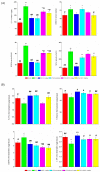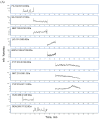Anti-Migraine Effect of the Herbal Combination of Chuanxiong Rhizoma and Cyperi Rhizoma and UPLC-MS/MS Method for the Simultaneous Quantification of the Active Constituents in Rat Serum and Cerebral Cortex
- PMID: 31207980
- PMCID: PMC6630925
- DOI: 10.3390/molecules24122230
Anti-Migraine Effect of the Herbal Combination of Chuanxiong Rhizoma and Cyperi Rhizoma and UPLC-MS/MS Method for the Simultaneous Quantification of the Active Constituents in Rat Serum and Cerebral Cortex
Abstract
Chuanxiong Rhizoma and Cyperi Rhizoma (CRCR), an ancient and classic formula comprised of Chuanxiong Rhizoma and Cyperi Rhizoma in a weight ratio of 1:2, has long been used for curing migraine. This study aimed to explore their anti-migraine effect and active constituents. A nitroglycerin (NTG)-induced migraine model in rats was established to evaluate pharmacological effects. Cerebral blood flow was detected by a laser Doppler perfusion monitor. The levels of endothelin-1 (ET-1), γ-aminobutyric acid (GABA), nitric oxide synthase (NOS), nitric oxide (NO), 5-hydroxytryptamine (5-HT), 5-hydoxyindoleacetic acid (5-HIAA), calcitonin gene-related peptide (CGRP) and β-endorphin (β-EP) were quantified with enzyme-linked immunosorbent assay. CGRP and c-Fos mRNA expression were quantified with quantitative real-time polymerase chain reaction. A UPLC-MS/MS method was developed and validated for the simultaneous quantification of active constituents in rat serum and cerebral cortex. CRCR significantly increased cerebral blood flow, decreased the levels of ET-1, GABA and NOS, and increased the levels of 5-HT, 5-HIAA and β-EP in NTG-induced migraine rats. CGRP levels and CGRP mRNA expression, as well as c-Fos mRNA expression in the brainstem were markedly down-regulated with the treatment of CRCR. After oral administration of CRCR, ferulic acid (FA), senkyunolide A (SA), 3-n-butylphthalide (NBP), Z-ligustilide (LIG), Z-3-butylidenephthalide (BDPH), cyperotundone (CYT), nookatone (NKT) and α-cyperone (CYP) were qualified in rat serum and cerebral cortex. The above results suggested that CRCR showed powerfully therapeutic effects on migraine via increasing the cerebral blood flow, decreasing the expression of CGRP and c-Fos mRNA, and regulating the releasing of ET-1, GABA, NOS, 5-HT, 5-HIAA, CGRP and β-EP in the serum and brainstem, consequently relieving neurogenic inflammation. The active constituents in CRCR for treating migraine were FA, SA, NBP, LIG, BDPH, CYT, NKT and CYP. These findings contributed for the further use of CRCR as a combinational and complementary phytomedicine for migraine treatment.
Keywords: Chuanxiong Rhizoma; Cyperi Rhizoma; UPLC-MS/MS; active constituents; migraine.
Conflict of interest statement
The authors declare no conflict of interest.
Figures











Similar articles
-
Identification and quantification of the quality markers and anti-migraine active components in Chuanxiong Rhizoma and Cyperi Rhizoma herbal pair based on chemometric analysis between chemical constituents and pharmacological effects.J Ethnopharmacol. 2020 Jan 10;246:112228. doi: 10.1016/j.jep.2019.112228. Epub 2019 Sep 9. J Ethnopharmacol. 2020. PMID: 31513838
-
Exploring the synergistic effects of chuanxiong rhizoma and Cyperi rhizoma in eliciting a rapid anti-migraine action based on pharmacodynamics and pharmacokinetics.J Ethnopharmacol. 2024 Dec 5;335:118608. doi: 10.1016/j.jep.2024.118608. Epub 2024 Jul 23. J Ethnopharmacol. 2024. PMID: 39053709
-
Volatile component interaction effects on compatibility of Cyperi Rhizoma and Angelicae Sinensis Radix or Chuanxiong Rhizoma by UPLC-MS/MS and response surface analysis.J Pharm Biomed Anal. 2018 Oct 25;160:135-143. doi: 10.1016/j.jpba.2018.07.060. Epub 2018 Jul 31. J Pharm Biomed Anal. 2018. PMID: 30086506
-
Angelica sinensis in China-A review of botanical profile, ethnopharmacology, phytochemistry and chemical analysis.J Ethnopharmacol. 2016 Aug 22;190:116-41. doi: 10.1016/j.jep.2016.05.023. Epub 2016 May 19. J Ethnopharmacol. 2016. PMID: 27211015 Review.
-
Ligusticum chuanxiong Hort.: a review of its phytochemistry, pharmacology, and toxicology.J Pharm Pharmacol. 2024 Nov 4;76(11):1404-1430. doi: 10.1093/jpp/rgae105. J Pharm Pharmacol. 2024. PMID: 39180449 Review.
Cited by
-
Real-world observations and impacts of Chinese herbal medicine for migraine: results of a registry-based cohort study.Front Pharmacol. 2024 Feb 2;15:1330589. doi: 10.3389/fphar.2024.1330589. eCollection 2024. Front Pharmacol. 2024. PMID: 38370478 Free PMC article.
-
A Reasonable Evaluation of Chuanxiong Rhizoma Processing with Wine through Comparative Pharmacokinetic Study of Bioactive Components: Dominant Effect on Middle Cerebral Artery Occlusion Model Rats.J Anal Methods Chem. 2022 Mar 14;2022:8252038. doi: 10.1155/2022/8252038. eCollection 2022. J Anal Methods Chem. 2022. PMID: 35321518 Free PMC article.
-
Mechanism of Traditional Chinese Medicine in Treating Migraine: A Comprehensive Review.J Pain Res. 2024 Sep 17;17:3031-3046. doi: 10.2147/JPR.S479575. eCollection 2024. J Pain Res. 2024. PMID: 39308997 Free PMC article. Review.
-
Reveal the Antimigraine Mechanism of Chuanxiong Rhizoma and Cyperi Rhizoma Based on the Integrated Analysis of Metabolomics and Network Pharmacology.Front Pharmacol. 2022 Mar 24;13:805984. doi: 10.3389/fphar.2022.805984. eCollection 2022. Front Pharmacol. 2022. PMID: 35401159 Free PMC article.
-
Correlation Analysis of Huayu Tongmai Decoction Intervention and Prognosis Indexes of Patients with Carotid Atherosclerosis.Evid Based Complement Alternat Med. 2021 Oct 31;2021:2739092. doi: 10.1155/2021/2739092. eCollection 2021. Evid Based Complement Alternat Med. 2021. PMID: 35256887 Free PMC article.
References
MeSH terms
Substances
Grants and funding
LinkOut - more resources
Full Text Sources
Other Literature Sources
Research Materials

